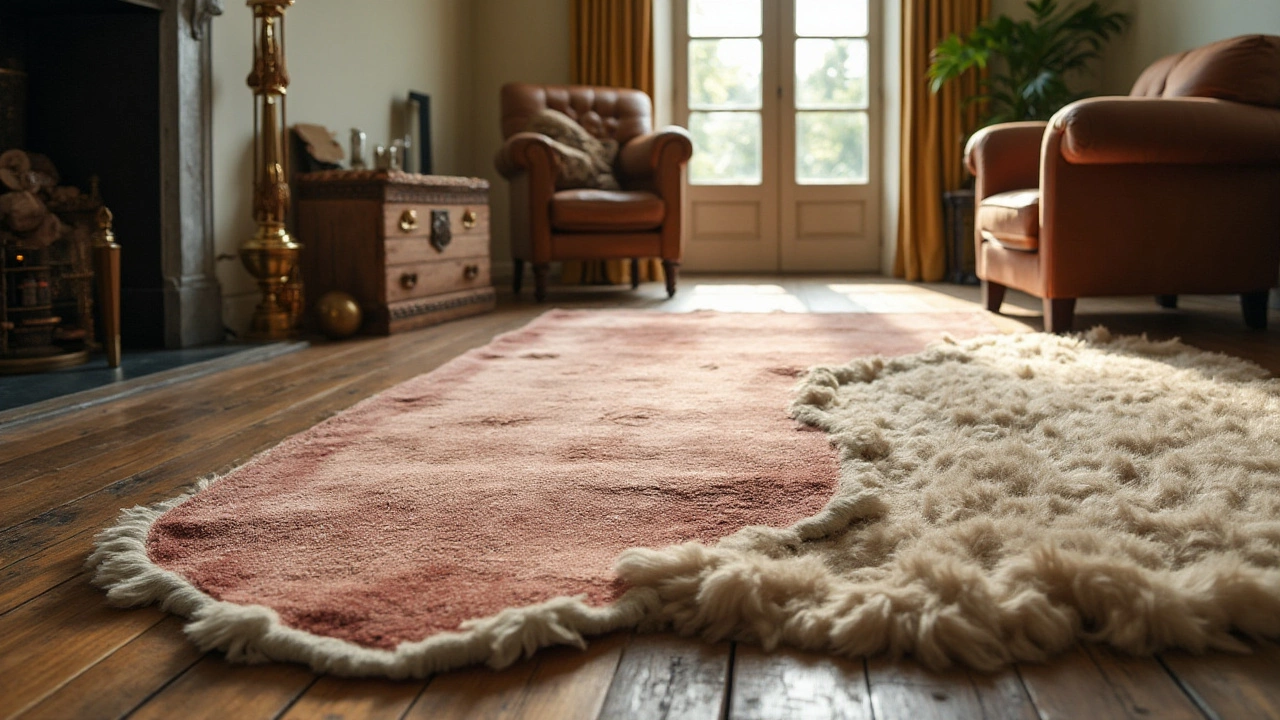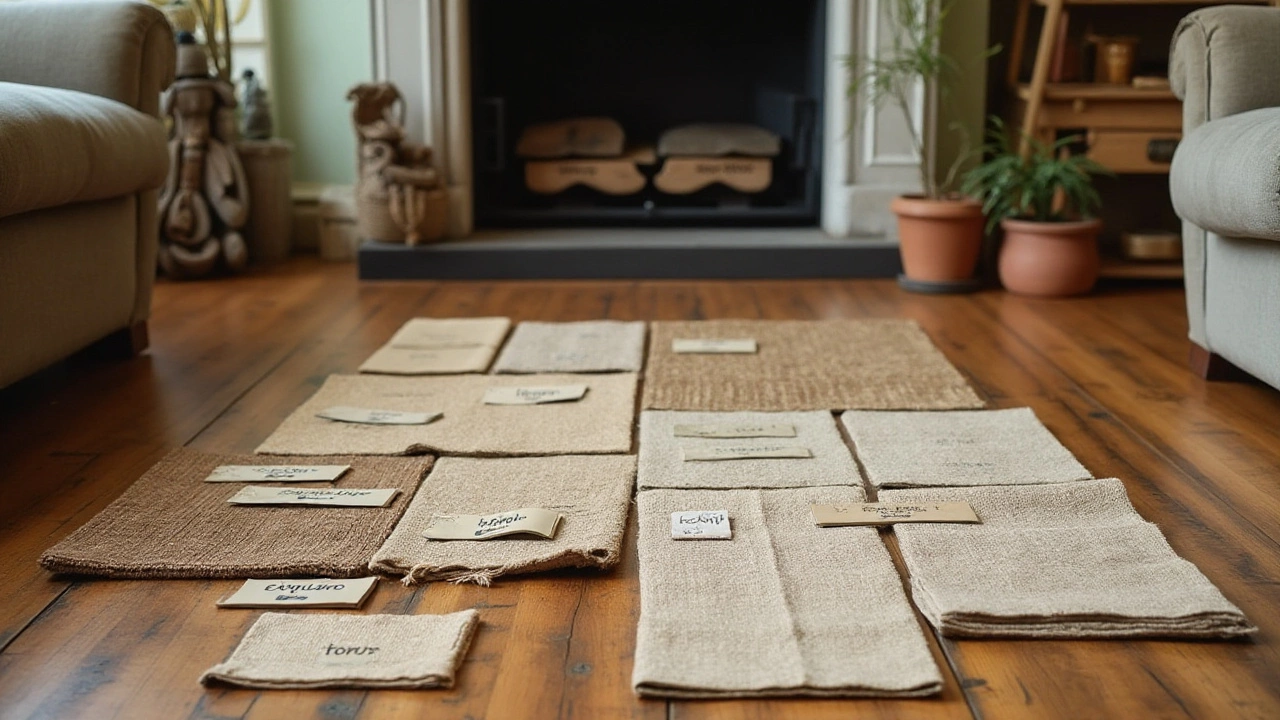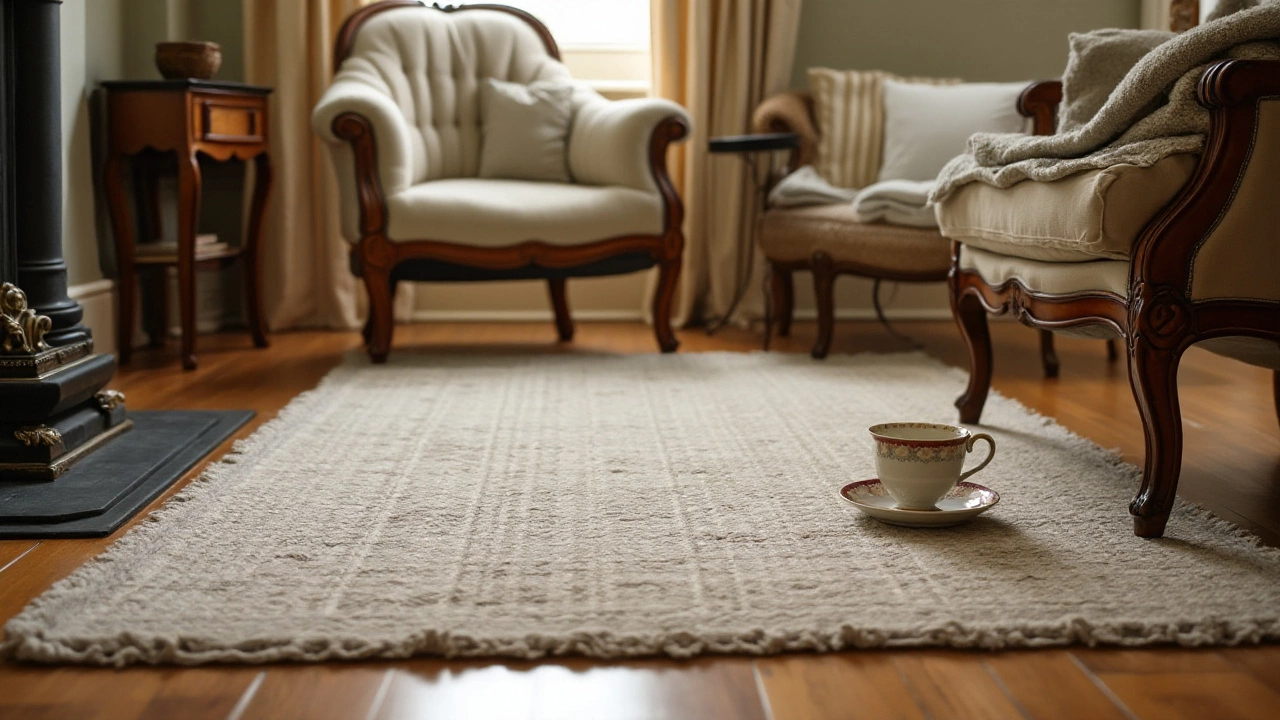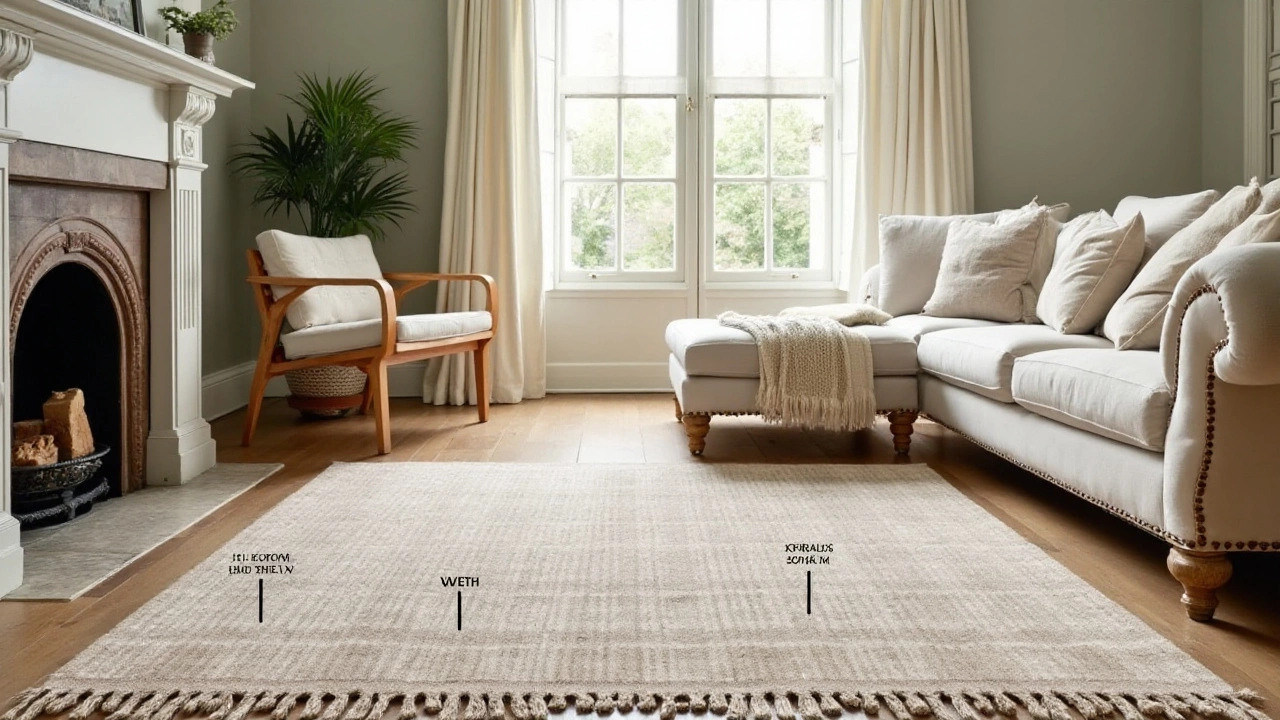Rug Materials to Avoid for Living Room Elegance
 Dec, 22 2024
Dec, 22 2024
Choosing the right rug for your living room can completely transform the space, adding warmth, style, and a cozy ambiance. However, making the wrong choice when it comes to rug materials can lead to a host of problems, from maintenance headaches to premature wear.
Various factors should be considered when selecting a rug, such as foot traffic, potential for spills, and the aesthetic you wish to achieve. Some materials, despite their initial appeal, might fall short in meeting these demands.
Understanding which materials to sidestep and why can save you time, money, and frustration in the long-run. Whether it's the tendency to trap stains or an inability to withstand the everyday hustle and bustle, being informed about rug materials is key to making a wise investment for your living room.
- Understanding Rug Materials
- Materials to Avoid and Why
- Alternatives for Living Room Rugs
- Tips for Choosing the Perfect Rug
Understanding Rug Materials
One might think that all rugs are created equal, yet the materials from which they are made are as diverse as the variety of styles available. This distinction is not only crucial concerning durability and maintenance but also impacts the health and comfort of your living space. Let's delve into the different types of rug materials, understanding their unique characteristics and potential drawbacks.
Starting with natural fibers, wool stands as a favored choice owing to its plush texture and remarkable resilience. A woolen rug, though oftentimes a bit more expensive, brings an undeniable warmth and luxury that many homes crave. It’s naturally stain-resistant and adapts well to different climates, which makes it a popular living room choice. However, wool can be a magnet for dust mites, which might not suit allergy sufferers. On another hand, cotton rugs, while generally lightweight and easy to clean, might not offer the same durability as wool. They tend to wear out quicker in high-traffic areas, demanding frequent replacements.
Now, shifting to synthetic materials: nylon and polyester top the list. These are appealing for their cost-effectiveness and vast range of colors and textures. A nylon rug, for instance, proves robust, handling heavy wear and tear with commendable grit while resisting mildew and mold, essential for a bustling household. Yet, be aware, synthetic rugs can trap odors more than their natural counterparts, sometimes leaving an overpowering 'plastic' scent unless routinely cleaned. Did you know some innovative brands have developed polyester rugs entirely from recycled plastic bottles? Such sustainable options rejuvenate our view on traditional materials, lending to an eco-friendlier household.
Silk, an epitome of elegance, crafts rugs often considered more art than mere home furnishings. A silk rug presents a high level of sheen and intricacy, symbolic in many cultures for representing prosperity and fine taste. It's important to note, however, that silk rugs are mostly decorative rather than practical. Their delicate nature makes them vulnerable to wear, necessitating careful placement away from direct foot traffic and sunlight, which can sap their colorful beauty. With the opulent expense of silk, some craftsmen use blends of silk and wool, granting durability without sacrificing too much of that silky essence.
An honorable mention must go to jute and sisal, fibers that garner praise for their rustic charm and understated aesthetic appeal. These botanical wonders grow quickly and offer a sustainable choice for eco-conscious buyers. They work fantastically in adding texture and a natural feel to any living space. But beware, these fibers can be rough underfoot and can absorb spills easily due to their porous nature, making stain prevention a key challenge. A quote from John Myers, a renowned interior designer, echoes this reality:
“Natural beauty comes at a cost, sometimes requiring more upkeep than initially anticipated.”
Reflecting on these varied materials, it becomes clear that there is no one-size-fits-all in the realm of home decor. Each material carries inherent strengths and potential drawbacks, which must be weighed against the practical needs and stylistic aspirations of each household. By understanding these materials, you can better navigate the landscape of rug selections, ensuring that the choice you ultimately make will be a lasting source of comfort and delight within your living room.

Materials to Avoid and Why
When picking a rug for your living room, understanding the drawbacks of certain materials can save you from future frustration. One of the most notorious materials to avoid is synthetic, such as polyester or olefin. Though often chosen for their affordability and initial appearance, these materials tend to flatten quickly and lack resilience. This means that over time, they can become threadbare in spots with high traffic or heavy furniture placement. Their resistance to stains is moderate, but persistent cleaning can sometimes cause discoloration, ruining their visual appeal.
Another material commonly advised against is viscose, also known as artificial silk. It might initially tempt with its lustrous sheen and soft touch, but viscose is notorious for being difficult to clean and prone to water damage, causing irreversible staining. Moreover, the fibers tend to break easily, leading to unsightly peeling and shedding that requires constant vacuuming. As a natural lookalike, it can mislead buyers into expecting durability that it simply cannot provide, unlike true silk or wool.
Cotton rugs, while breathable and affordable, may not be the best choice for a bustling living room. Over time, they can lose their shape due to stretching. Frequent washing, which might seem like an advantage due to their fabric, can lead to fading and deterioration. The natural fibers, while comfortable underfoot, often lack the durability needed for rooms with high use.
"It's practical to bypass attractive yet impractical materials for your living room rug," advises interior designer Anika Sharma. "Initially glossy and charming options, often fall short, demanding more maintenance than expected."
Finally, jute and other natural fiber rugs have a place in decor but are perhaps ill-suited for living rooms where more resilience is required. These materials, while environmentally friendly, absorb moisture and often stain easily, making them harder to maintain. They also tend to be rougher compared to other materials, which won't provide the gentle underfoot comfort that family and guests will appreciate during long lounging periods.
To make the best choice for your living room, being aware of these pitfalls with certain rug materials allows for a smarter investment, ensuring the piece not only complements your decor but also stands up to family life.

Alternatives for Living Room Rugs
When it comes to choosing the perfect rug for your living room, alternatives to the usual natural fibers and synthetic options abound, each bringing their own unique benefits and styles. One increasingly popular option is the wool rug. Known for its unmatched durability and softness, wool can withstand the heaviest foot traffic while providing a luxurious feel beneath your feet. Wool's natural elasticity makes it a great choice for areas like the living room where furniture might need rearranging, as it resists crushing and retains its shape well.
Another excellent choice is cotton rugs. Generally more affordable than wool, they offer a soft touch and are easy to clean, making them ideal for families with children or pets. Cotton rugs come in a multitude of designs and colors, allowing homeowners to easily update the look of their space. Their lighter weight also means they can be easily moved or replaced, making seasonal decorating a breeze.
For those who prefer a more natural aesthetic, jute and sisal rugs present an earthy, rustic appearance. These fibrous materials are biodegradable and sustainable, which adds a level of eco-friendliness to your home decor. Though they might not offer the same plushness as wool or cotton, their texture provides a lovely contrast in minimalistic or nature-inspired rooms. Their durability is commendable, but keeping them in minimally wet areas is advisable as exposure to moisture can cause wear.
"Rug choice can significantly impact both the aesthetics and functionality of your living room," says renowned interior designer, Emily Henderson. "Selecting the right material can boost your home's character and livability."
If you're someone who loves to add a touch of contemporary flair to their home, synthetic fiber rugs such as polypropylene or nylon provide an array of vibrant colors and patterns. These materials are stain-resistant and easy to clean, although their synthetic nature might not offer the same luxurious feel as wool or cotton. However, they do shine in spaces prone to spills and heavy usage, ensuring a longer lifespan with minimal maintenance.
Lastly, seagrass rugs offer a smooth texture and a lovely, organic hue. They are wonderfully low-maintenance, repel water naturally, and resist stains, which makes them a suitable option for homes with children. While they might not be the softest underfoot, they bring a durable yet stylish element to your living room floor, particularly complementing coastal or casual decor styles.
Choosing the right alternative from among these diverse options will depend greatly on your lifestyle, aesthetic preference, and the demands of your household environment. With a little research, you can find a living room rug that not only matches your decor but also serves your home's functional needs beautifully.

Tips for Choosing the Perfect Rug
When it comes to choosing the perfect rug for your living room, it pays to be both discerning and deliberate. This isn't merely about selecting a pretty fabric to fill an empty space—there's an art to it that involves ensuring your new addition not only fits your decor but serves functional purposes as well. Think of your rug as a canvas, setting the scene beneath your furniture arrangement and offering visual and physical comfort. A well-chosen rug can anchor a room and delineate boundaries within open-plan spaces, which is why the material selection holds particular relevance.
Start by assessing the scale and dimensions of your room. A common mistake is choosing rugs that are either too small or too large for the living space. Ideally, consider rugs that extend about 18 inches beyond the edge of your furniture. This rule of thumb offers a balanced look without appearing overstated or cramped. Material is criticizable too; durables such as wool or synthetic materials can handle high-traffic areas efficiently. In contrast, delicate materials like silk may be better suited for lesser-trafficked zones or as decorative throws.
Before committing, evaluate the interplay of colors and patterns present in the room. A rug with intricate patterns can effectively hide minor stains or wear, whereas a bold color option might become a statement piece dictating other design elements. Designers recommend utilizing the 60-30-10 color rule: 60% of a primary color, 30% of a secondary color, and 10% for accent hues. This helps ensure the rug harmonizes rather than clashes with other textiles and finishes. Durability is yet another aspect to keep in mind. If you're expecting spills or pet wear, opt for stain-resistant options that incorporate the latest fiber technologies.
"The right rug is like a foundation; it sets the tone and mood for the rest of the interior," said interior designer, Jane Pearson.
Shopping for rugs can seem overwhelming, but simplifying the process with priorities in mind makes a huge difference. Budget is always a determining factor, and being upfront with yourself about your spending limits helps you target better-suited options straight away. Rugs come in various price ranges largely determined by material, size, and method of production. Hand-knotted or hand-tufted designs, for instance, come with a higher price tag but offer unique craftsmanship and durability. For budget-conscious selections, don't discount synthetic blends which mimic luxury fibers remarkably well.
We also can't underestimate the importance of texture. Rugs add another layer to the tactile feel of a room, inviting touch and transforming acoustics by softening sound. Consider tactile complements: a soft rug brings warmth against hardwood floors, while a denser fiber may feel more at home on plush carpets. Factor in maintenance too. Regular vacuuming and occasional professional cleaning may be prerequisites depending on the material choice, particularly in homes prone to allergens brought in by pets. Living room rugs can profoundly impact the ambiance of your home, so consider these nuances when making your selection. Foresight not only augments aesthetics but ensures your investment thrives through the years."